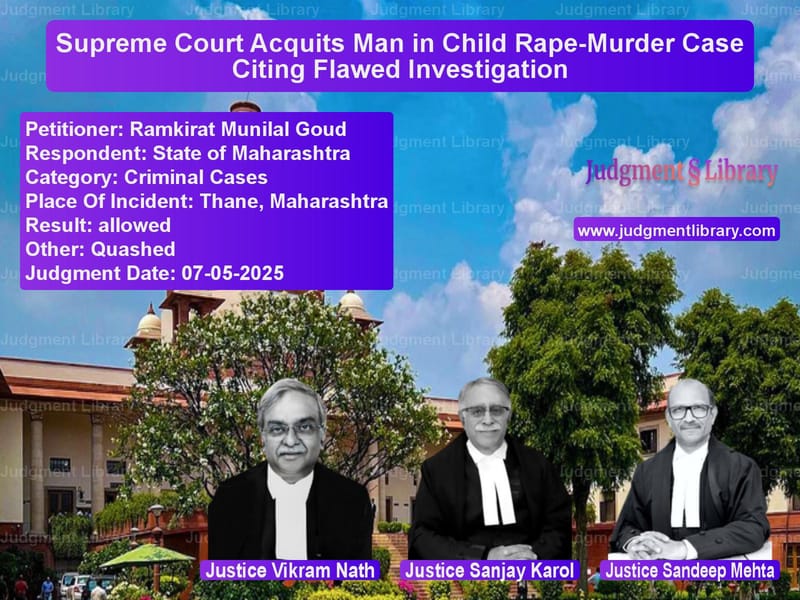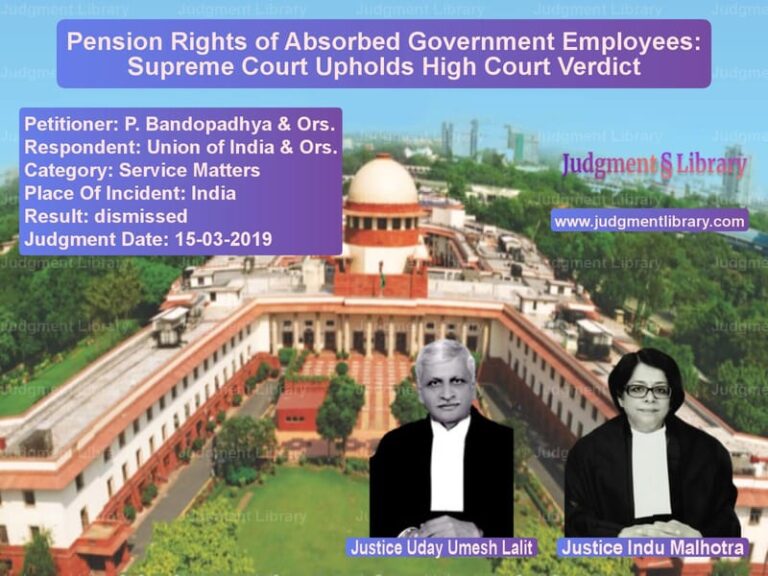Supreme Court Acquits Man in Child Rape-Murder Case Citing Flawed Investigation
In a powerful judgment that exposes critical flaws in criminal investigation and prosecution, the Supreme Court of India has acquitted a man who spent 12 years in prison—including 6 years facing the death penalty—for the alleged rape and murder of a 3-year-old girl. The case, which highlights how investigative failures can lead to wrongful convictions, saw the Court meticulously dismantle the prosecution’s evidence piece by piece, revealing a disturbing pattern of shoddy investigation and witness manipulation.
The tragic case began on September 30, 2013, when a 3-year-old girl went missing from her home in Old Waghbil Gaon, Banjari Chawl, Laxminagar, Thane. Her father, Manoj Bhaskar Sadavarte, returned home around 10:45 AM to find his daughter and their pet dog missing. After searching the neighborhood, he found the dog in a nearby watchmen chawl but there was no sign of his daughter. He immediately filed a missing person report at Police Station Kasarvadavali, Thane.
Two days later, on October 2, 2013, the child’s body was found in a muddy pond about one kilometer from the watchmen chawl. The post-mortem examination revealed horrific injuries to her genitalia and anus, along with skull fractures that were determined to be the cause of death. The case had now turned from a missing person report to a brutal rape and murder investigation.
The prosecution built its case around three main circumstantial evidence links: the “last seen together” theory, an alleged extra-judicial confession, and forensic evidence linking soil from the crime scene to the accused’s shoes. Based on this evidence, the trial court convicted Ramkirat Munilal Goud and sentenced him to death for murder, life imprisonment for rape, and additional prison terms for kidnapping and destroying evidence. The Bombay High Court later confirmed both the conviction and death sentence.
The Supreme Court’s Scrutiny of Evidence
When the case reached the Supreme Court, the bench comprising Justices Vikram Nath, Sanjay Karol, and Sandeep Mehta conducted a thorough examination of the evidence. What they found was deeply troubling.
The Court began by reiterating the fundamental legal principles governing cases based purely on circumstantial evidence. Quoting from the landmark case of Sharad Birdhichand Sharda v. State of Maharashtra, the Court emphasized: “the circumstances from which the conclusion of guilt is to be drawn should be fully established. The facts so established should be consistent only with the hypothesis of the guilt of the accused… they should exclude every possible hypothesis except the one to be proved, and there must be a chain of evidence so complete as not to leave any reasonable ground for the conclusion consistent with the innocence of the accused.”
Applying these principles to the present case, the Court found the prosecution’s evidence severely lacking.
The Last Seen Theory Collapses
The prosecution’s star witnesses—Dipendrakumar Dhirendranath Shukla (PW-9) and Pradipkumar Ganesh Rawat (PW-14)—claimed to have seen the accused with the child on the day she went missing. However, the Court found their testimony fundamentally unreliable.
The Court noted the suspicious conduct of these witnesses: “What is pertinent to note from the statement of this witness is that he was aware on 30th September, 2013, itself that the child victim had gone missing and people were searching for her. The police visited the vicinity on 30th September, 2013; 1st October, 2013 and 2nd October, 2013 as well, but the witness (PW-9) did not divulge the vital information to the police that he had seen the child with the dog in the vicinity of watchmen chawl and the accused appellant coming out of the bushes. Apparently, thus, the conduct of the witness in maintaining stoic silence and not divulging to the police at the first available opportunity… makes his entire testimony doubtful.”
Even more damning was the revelation that these witnesses’ statements were recorded only on October 3, 2013, despite their names appearing in the spot panchnama prepared on October 1. The Court observed: “Thus, we have no hesitation in holding that the witnesses, namely, Dipendrakumar Dhirendranath Shukla (PW-9) and Pradipkumar Ganesh Rawat (PW-14), were created by the Investigating Officers, by way of padding, because a case of sensational nature was not being solved. Their evidence is totally false and unworthy of credence.”
The Extra-Judicial Confession Unravels
The prosecution’s second pillar of evidence—an alleged extra-judicial confession made by the accused to his supervisor, Anil Mahatam Singh (PW-17)—also crumbled under scrutiny.
The Court found that the witness’s testimony had been manipulated through leading questions during cross-examination by the prosecutor. More importantly, the witness’s original statement recorded under Section 164 of the CrPC contained no mention of any confession. The Court noted: “Thus, in the previous statement of the witness (PW-17) recorded under Section 164 of the CrPC, there is no reference to any extra-judicial confession having been made by the accused appellant. Furthermore, the statement of the said witness under Section 161 of the CrPC was recorded as late as on 12th October 2013.”
The Court concluded: “Hence, the statement of the witness (PW-17) on the aspect of extra-judicial confession is full of improvements and contradictions and hence, it is totally unreliable.”
Forensic Evidence Falls Short
The prosecution’s scientific evidence also failed to impress the Court. The FSL report showing similarity between soil on the accused’s shoes and soil from the pond where the body was found was deemed “absolutely vague and inconclusive.”
The Court explained why this evidence was insufficient: “If at all, the prosecution desired to prove without any exception that the soil found on the shoes of the accused appellant was unexceptionally from the location from where the dead body of the child victim was recovered, then the Investigating Officer (PW-18) should have collected soil samples from the other places frequented by the accused appellant. Then only the possibility of the soil not being from any other place visited by the accused appellant could have been excluded.”
Other forensic evidence, including DNA analysis and blood sample comparisons, either yielded negative results or were inconclusive. Notably, the prosecution withheld reports of forensic samples taken from other watchmen, leading the Court to draw an adverse inference.
Investigation Under the Microscope
The Supreme Court reserved its strongest criticism for the investigating officers, whose work it described as “shabby and perfunctory.” The judgment paints a picture of an investigation that was not just incompetent but potentially manipulative.
The Court highlighted numerous investigative failures: the first investigating officer failed to record statements of crucial witnesses despite their names appearing in the spot panchnama; no effort was made to collect soil samples from other locations to establish uniqueness; and the recovery of incriminating articles was highly suspect.
Regarding the recovery of the accused’s clothing and shoes, the Court noted: “Both the Investigating Officers had made extensive investigation in the entire area and this definitely would have included the search of the room of the accused appellant. At this stage, it is pertinent to note that Vikas Sarjerao Lokre (PW-16) admitted in his cross-examination that he had visited the watchmen chawl on 1st October 2013. Hence, if at all, these articles were lying in the room of the accused appellant, they would not have escaped the notice of the 1st Investigating Officer (PW-16). Clearly thus, the factum of recovery of incriminating articles at the instance of the accused appellant by the 2nd Investigating Officer (PW-18) does not inspire confidence.”
A Broken System
The Supreme Court’s judgment reveals a criminal justice system under stress, where the pressure to solve sensational crimes can lead to investigative shortcuts and wrongful convictions. The Court observed: “The instant case is yet another classic example of shabby and perfunctory investigation leading to failure of the prosecution case involving a gruesome incident of rape and murder… Despite the shabby investigation, the overzealous approach of the Courts below, to impart justice, in a sense that someone must be held responsible for the crime, has led to the conviction of the appellant herein.”
The Court noted the human cost of these failures: “Despite there being hardly any reliable evidence on the record of the case, the accused appellant was convicted and sentenced by the Courts below and has suffered incarceration for almost 12 years of which 6 years were under the Damocles sword of death penalty.”
Acquittal and Release
In its final analysis, the Supreme Court concluded that the prosecution had failed to establish a complete chain of circumstantial evidence pointing unequivocally to the accused’s guilt. The Court allowed the appeal, acquitted Ramkirat Munilal Goud of all charges, and ordered his immediate release unless required in any other case.
The judgment quashed and set aside both the trial court’s conviction and sentence order dated March 5 and 8, 2019, and the High Court’s confirmation judgment dated November 25, 2021.
Broader Implications
This judgment serves as a stark reminder of the importance of thorough and unbiased criminal investigation. It highlights how procedural lapses, witness manipulation, and forensic shortcomings can lead to grave miscarriages of justice.
While the Court’s decision brings closure to a man wrongfully imprisoned for over a decade, it also leaves unresolved the brutal crime against a 3-year-old child. The real perpetrator remains free, and the child’s family continues to seek justice.
The case underscores the delicate balance courts must maintain between the need to convict the guilty and the constitutional imperative to protect the innocent. As the Supreme Court demonstrated, when evidence fails to meet the rigorous standards of proof required in criminal cases—particularly those involving the death penalty—acquittal becomes the only constitutionally permissible outcome, no matter how heinous the crime.
Petitioner Name: Ramkirat Munilal Goud.Respondent Name: State of Maharashtra.Judgment By: Justice Vikram Nath, Justice Sanjay Karol, Justice Sandeep Mehta.Place Of Incident: Thane, Maharashtra.Judgment Date: 07-05-2025.Result: allowed.
Don’t miss out on the full details! Download the complete judgment in PDF format below and gain valuable insights instantly!
Download Judgment: ramkirat-munilal-gou-vs-state-of-maharashtra-supreme-court-of-india-judgment-dated-07-05-2025.pdf
Directly Download Judgment: Directly download this Judgment
See all petitions in Murder Cases
See all petitions in Rape Cases
See all petitions in Bail and Anticipatory Bail
See all petitions in Custodial Deaths and Police Misconduct
See all petitions in Other Cases
See all petitions in Judgment by Vikram Nath
See all petitions in Judgment by Sanjay Karol
See all petitions in Judgment by Sandeep Mehta
See all petitions in allowed
See all petitions in Quashed
See all petitions in supreme court of India judgments May 2025
See all petitions in 2025 judgments
See all posts in Criminal Cases Category
See all allowed petitions in Criminal Cases Category
See all Dismissed petitions in Criminal Cases Category
See all partially allowed petitions in Criminal Cases Category







